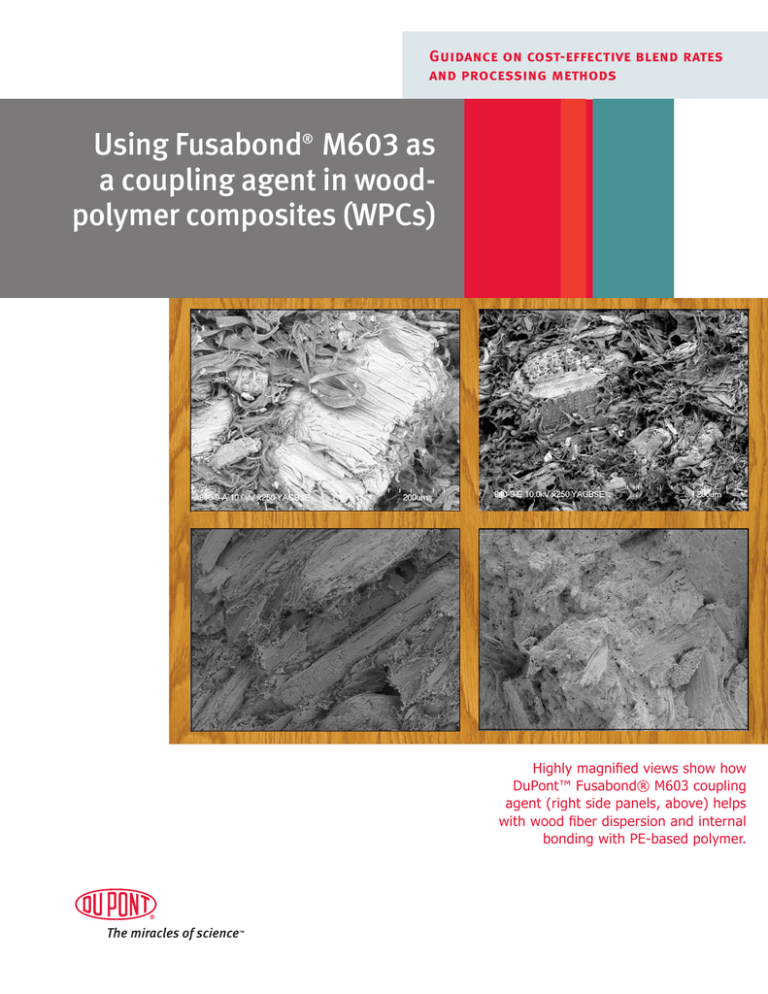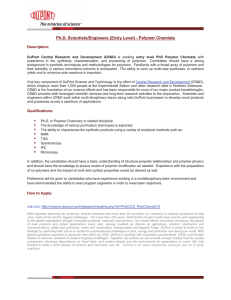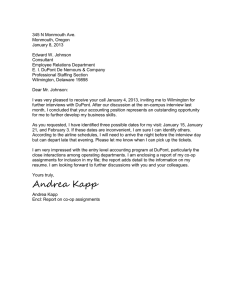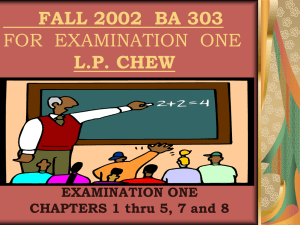
Guidance on cost-effective blend rates
and processing methods
Using Fusabond® M603 as
a coupling agent in woodpolymer composites (WPCs)
Highly magnified views show how
DuPont™ Fusabond® M603 coupling
agent (right side panels, above) helps
with wood fiber dispersion and internal
bonding with PE-based polymer.
PROCESSING GUIDE
Product Description
DuPont™ Fusabond® M603 resin is an ethylene copolymer,
incorporating a monomer which is classified as being a
maleic anhydride equivalent for application uses. The exact
composition is DuPont proprietary information.
This unique technology can produce both substantial
strength improvement and increased moisture resistance in
wood/polyethylene composites (WPCs) at significantly lower
usage levels than conventional maleic anhydride coupling
agents. At higher levels, it provides superior performance
for dramatic reduction in water absorption.
Recommended Application of Fusabond® M603 in WPC
1. WPC Compositions
a.) Type of Bio-Fibers and Concentration:
Based on the chemical structure and physical properties
(e.g., melt viscosity) of the Fusabond® M603 resin, DuPont
expects this coupling agent to interact with a variety of biofibers. Studies have been conducted with both hardwood
fibers, in particular oak fibers, as well as pine softwood
fibers. Fusabond® M603 has also been shown to work well
with rice hulls. There are many other ceullosic and organic
materials that may also interact with Fusabond® M603.
The typical concentration of fibers in WPC has been
between 40-60 wt%. These could be virgin or recycled
fibers. Generally the size of wood fibers used are 40-60
mesh.
c.) Additives
Fusabond® M603 performance is not affected in the
presence of additives typically used in WPC compositions.
For example, Fusabond® M603 has been tested in the
presence of 5 wt% talc. It is expected that Fusabond®
M603 will improve coupling and dispersion of the additive or
filler in the polymer matrix.
Most significantly, lubricants are commonly used in WPC
formulations to increase throughput and reduce edge “tear”
as the material exits the die. Typical lubricant dosages are
between 3-6 wt%. There are generally two classes of
lubricants: metal stearate based, and organic based (nonmetal stearate). Metal stearates are the most cost-effective
and efficient; however, they interact negatively with
traditional maleic anhydride grafted coupling agents. It has
been shown that Fusabond® M603 remains effective in the
presence of metal stearate based lubricants. Fusabond®
M603 can be used with the more expensive organic
lubricants, as well, but may not be as effective as when
used with the less expensive metal stearate lubricants.
2. Processing and Process Variables
DuPont™ Fusabond® M603 can be used in processing
equipment typically used for WPC processing such as
extrusion, compression and injection molding equipment.
The most common processes are single-screw and twinscrew extrusion. One should be aware that processing and
dosage of Fusabond® M603 may change between singlestage and dual-stage units.
It is strongly recommended that the wood fiber be dried
prior to coming in contact with Fusabond® M603. Ideally
the moisture content of wood fibers should be below 0.5
wt%. Wood fiber drying is a potentially hazardous process
and should be done in consultation with equipment
suppliers.
Fusabond® M603 resin is fed to the processing equipment
in a variety of ways, including:
b.) Type of Polymer Matrix
Fusabond® M603 is an ethylene copolymer and as such
is recommended for use with polyethylene based WPC,
although it may have benefits to composites based on other
polymers. The polyethylene matrix can be high-, linear-lowor low-density polyethylene (HDPE, LLDPE or LDPE) or any
combination of these polymers. The resin can come from
virgin, post industrial or post consumer recycled sources as
long as it is properly prepared.
•
independent using a dedicated accurate loss and weigh
feeder;
•
dry-blended with the matrix polymer (care must be
taken in the uniformity of the dry-blend);
•
fed downstream of the main polymer feed but before
the cellulose addition point.
Fusabond® M603 is used in typical WPC process
conditions. The melt temperature for processing wood
fiber composite is kept below 200°C (390°F). According to
its material safety data sheet, the maximum processing
temperature for Fusabond® M603 is 260°C (500°F).
DUPONT™ FUSABOND® M603 COUPLING AGENT FOR WOOD POLYMER COMPOSITES
At recommended processing temperatures, small
amounts of fumes may evolve from the resins. When
resins are overheated, more extensive decomposition
may occur. Adequate ventilation should be provided to
remove the fumes from the work area.
If a maleic anhydride grafted polyethylene is currently
being used, customers can typically cut the addition levels
significantly when using Fusabond® M603.
As stated, it is recommended strongly that the wood
fiber is dried (< 0.5wt%) before processing. The water
released can negatively impact the reactivity of coupling
agents including Fusabond® M603. The presence of
a vacuum port is essential to remove other moisture
present and other gases evolved during processing,
including small off-gases from Fusabond® M603.
3. Recommended Dosage of Fusabond® M603
The recommended dosage of Fusabond® M603 in
composite formulation will depend on a number of
factors, including the target property goals such as
Modulus of Rupture (MOR), Modulus of Elasticity (MOE)
and moisture uptake. Other factors include cellulose
type, cellulose, additive and filler levels, quality of the
matrix polymer(s) and processing equipment.
Due to the high reactivity of Fusabond® M603, DuPont
recommends keeping the concentration of Fusabond®
M603 below 1.0 wt% when a high intensity, 1-stage
process is used to make the WPC profile. An example of
such a process is a conical twin-screw process feeding
profile die (typically includes a gear pump). In a 2-step
process where ingredient mixing and profile
extrusion are separated, the loading of
Fusabond® M603 can be further increased
to 2.0 wt%. In either case for a detailed
recommendation, customers should
contact their local DuPont representative.
During initial evaluation, DuPont
recommends testing at two levels:
•
0.5% and 1.0% Fusabond®
M603 for 1-stage systems;
•
or 0.75% and 1.5% for 2-stage
systems.
Fusabond® M603 coupling agent can be used
with a variety of lubricants for extruder torque
reduction or improved line speeds when making
high-strength, high-modulus wood alternatives.
DUPONT™ FUSABOND® M603 PROCESSING GUIDE, WPCs
Troubleshooting Guidelines
High amps or torque: If the extruder motor amps or torque
increases suddenly, the DuPont™ Fusabond® M603 may
have very high reactivity in the system. Stop addition of the
Fusabond® M603 (or replace with polyethylene) and restart
the test with a lower level of Fusabond® M603. Consult your
DuPont representative for additional suggestions.
Disclaimer
This information corresponds to our current knowledge on the
subject. It is offered solely to provide possible suggestions for your
own determinations. It is not intended, however, to substitute for
any testing you may need to conduct to determine for yourself
the suitability of our products for your particular purposes. It is the
user’s responsibility to determine the level of risk and the proper
protective equipment needed for the user’s particular purposes.
This information may be subject to revision as new knowledge
and experience becomes available. Since we cannot anticipate
all variations in actual end-use conditions, DUPONT MAKES NO
WARRANTIES AND ASSUMES NO LIABILITY IN CONNECTION
WITH ANY USE OF THIS INFORMATION. Nothing in this
publication is to be considered as a license to operate under or a
recommendation to infringe any trademark or patent right.
While DuPont believes that the procedure set forth in this publication can be used to safely
and effectively make wood polymer composites, DuPont does not warrant or guarantee the
completeness, efficacy or safety of the process or its use. The information contained herein
is intended for use only by competent personnel in designing and operating a facility to make
WPC, and the user of this information accepts full responsibility for its use. Consistent with the
foregoing, anyone using this information shall indemnify and hold DuPont harmless from any
loss, claim, damage, or injury to persons or property whatever the cause may be arising out of
or pertaining to the use of the information, unless the same is shown by the user to have been
caused directly by bad faith or willful misconduct on the part of DuPont. This publication is not
to be taken as a license to operate under, or a recommendation to infringe, any patents.
REGIONAL CONTACT CENTERS
for DuPont™ Fusabond® M603
coupling agent
DuPont Industrial Polymers
Wilmington, Delaware U.S.A.
Telephone +1 302 992 4557
Toll-free (USA) 800 438 7225
DuPont do Brasil, S.A.
Barueri, Sao Paulo, Brasil
Telephone +55 11 4166 8000
DuPont China Holding Co., Ltd.
Pudong New District, Shanghai
Telephone +86 21 3862 2888
DuPont de Nemours Int’l. S.A.
Geneva, Switzerland
Telephone +41 22 717 51 11
fusabond.dupont.com
The DuPont Oval, DuPont™, The miracles of science™ and Fusabond® are trademarks or
registered trademarks of DuPont or its affiliates.
Copyright © 2012 E.I. du Pont de Nemours and Company. All rights reserved.
K-25780-1 (03/2012)





